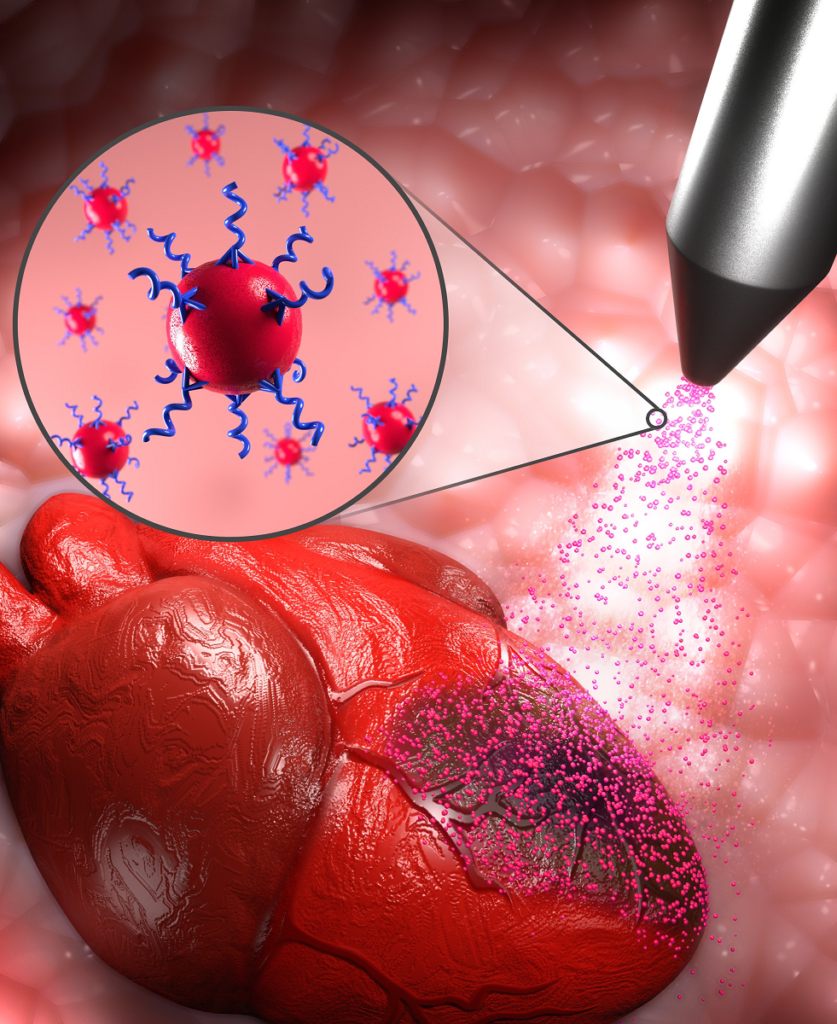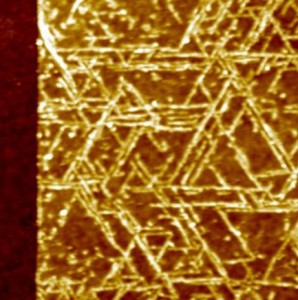
That is a pretty stunning image and this March 15, 2022 news item on phys.org provides an explanation of what you see (Note: A link has been removed),
Could a spritz of super-tiny particles of gold and peptides on a damaged heart potentially provide minimally invasive, on-the-spot repair?
Cutting-edge research led by University of Ottawa Faculty of Medicine Associate Professors Dr. Emilio Alarcon and Dr. Erik Suuronen suggests a spray-on technology using customized nanoparticles of one of the world’s most precious metals offers tremendous therapeutic potential and could eventually help save many lives. Cardiovascular diseases are the leading cause of death globally, claiming roughly 18 million lives each year.
In a paper recently published online in ACS Nano, a peer-reviewed journal that highlighted the new research on its supplementary cover, Dr. Alarcon and his team of fellow investigators suggest that this approach might one day be used in conjunction with coronary artery bypass surgeries. That’s the most common type of heart surgery.
A March 15, 2021 University of Ottawa news release (also on EurekAlert) by David McFadden, which originated the news item, describes the research in more detail (Note: A link has been removed),
The therapy tested by the researchers – which was sprayed on the hearts of lab mice – used very low concentrations of peptide-modified particles of gold created in the laboratory. From the nozzle of a miniaturized spraying apparatus, the material can be evenly painted on the surface of a heart within a few seconds.
Gold nanoparticles have been shown to have some unusual properties and are highly chemically reactive. For years, researchers have been employing gold nanoparticles – so tiny they are undetectable by the human eye – in such a wide range of technologies that it’s become an area of intense research interest.
In this case, the custom-made nanogold modified with peptides—a short chain of amino acids —was sprayed on the hearts of lab mice. The research found that the spray-on therapy not only resulted in an increase in cardiac function and heart electrical conductivity but that there was no off-target organ infiltration by the tiny gold particles.
“That’s the beauty of this approach. You spray, then you wait a couple of weeks, and the animals are doing just fine compared to the controls,” says Dr. Alarcon, who is part of the Faculty of Medicine’s Department of Biochemistry, Microbiology and Immunology and also Director of the Bio-nanomaterials Chemistry and Engineering Laboratory at the University of the Ottawa Heart Institute.
Dr. Alarcon says that not only does the data suggest that the therapeutic action of the spray-on nanotherapeutic is highly effective, but its application is far simpler than other regenerative approaches for treating an infarcted heart.
At first, the observed improvement of cardiac function and electrical signal propagation in the hearts of tested mice was hard for the team to believe. But repeated experiments delivered the same positive results, according to Dr. Alarcon, who is part of the Faculty of Medicine’s Department of Biochemistry, Microbiology and Immunology and Director of the Bio-nanomaterials Chemistry and Engineering Laboratory at the University of Ottawa Heart Institute.
To validate the exciting findings in mice, the team is now seeking to adapt this technology to minimally invasive procedures that will expedite testing in large animal models, such as rabbits and pigs.
Dr. Alarcon praised the research culture at uOttawa and the Heart Institute, saying that the freedom to explore is paramount. “When you have an environment where you are allowed to make mistakes and criticize, that really drives discoveries,” he says.
The team involved in the paper includes researchers from uOttawa and the University of Talca in Chile. Part of the work was funded by the Canadian government’s New Frontiers in Research Fund, which was launched in 2018 and supports transformative high risk/high reward research led by Canadian researchers working with local and international partners.
Here’s a link to and a citation for the paper,
Nanoengineered Sprayable Therapy for Treating Myocardial Infarction by Marcelo Muñoz, Cagla Eren Cimenci, Keshav Goel, Maxime Comtois-Bona, Mahir Hossain, Christopher McTiernan, Matias Zuñiga-Bustos, Alex Ross, Brenda Truong, Darryl R. Davis, Wenbin Liang, Benjamin Rotstein, Marc Ruel, Horacio Poblete, Erik J. Suuronen, and Emilio I. Alarcon. ACS Nano 2022, 16, 3, 3522–3537 DOI: https://doi.org/10.1021/acsnano.1c08890 Publication Date: February 14, 2022 Copyright © 2022 The Authors. Published by American Chemical Society
This paper appears to be open access.
